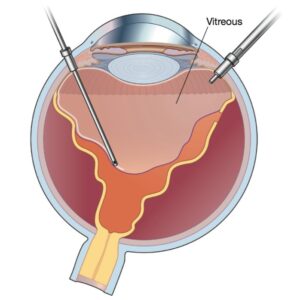Vitreoretinal Surgeon and Specialist in Jabalpur
Dr Pawan Sthapak eye specialist in Jabalpur of Janjyoti Eye Hospital, provides vitreoretinal surgical eye care solutions for patients.
The vitreoretinal surgeon, Dr Pawan Sthapak, of JanJyoti Eye Hospital, provides medical, Surgical care for the whole family The surprising results of the surgery will be significant. This is because the vitreoretinal surgeon provides proper attention to the cornea condition to make sure that the overall outcome is positive.
Corneal Problems After Vitreoretinal
It has been observed repeatedly that corneal problems after vitreoretinal surgery, start from infections and can reach epithelial and neurotrophic keratitis and defects. All vitreoretinal Surgeons are aware that there is an increased risk of patients getting infected.
Process of Vitreoretinal Surgery
The vitreoretinal surgeon studies the patient’s medical history before going for an operation. Vitreoretinal surgeons are trained to do any kind of surgery on the vitreous and can do things like remove cataracts, transplant corneas, put in lenses, and more.
Vitreoretinal surgery on patients with diabetes is safer nowadays than it used to be earlier. This leads to fewer anterior segment and corneal problems.
Less dissection can be made using ocular surface instrumentation of small-gauge that makes vitreoretinal surgery safer, generating less vascularization after the operation and reducing ocular surface irritation.

Side-effects of Vitreoretinal eye surgery
Vitreoretinal surgery on patients with diabetes is safer nowadays than it used to be earlier. This leads to fewer anterior segment and corneal problems. Less dissection can be made using ocular surface instrumentation of small-gauge that makes vitreoretinal surgery safer, generating less vascularization after the operation and reducing ocular surface irritation.
However, diabetes patients normally have to compromise blood flow and nerves, causing certain complications, like non-healing defects of corneal epithelial and abnormal vascularization. The vitreoretinal surgeon studies the patient’s medical history before going for an operation.
Why Choose Vitreoretinal eye surgery
Vitreoretinal eye surgery is a sequence of procedures that are done deep inside the eye with lasers or traditional surgical tools. This delicate surgery takes place where the gel-like vitreous and light-sensitive membrane (retina) is located, as the name suggests.
Several types of age-related macular degeneration, diabetic retinopathy, diabetic vitreous haemorrhage, macular hole, a detached retina, Epiretinal membrane, and CMV retinitis can be treated with vitreoretinal surgical and laser techniques that restore, preserve, and improve vision.
Conditions necessitating a vitrectomy methodology
A vitrectomy is a surgical procedure that removes the vitreous or gel-like substance, from the eye. This method can treat vision problems caused by foreign matter invading the normally sterile interior of the eye. In conditions such as diabetic vitreous hemorrhage, blood is an example of foreign matter.
When light passes through the eye, the foreign object casts shadows on the retina. This makes it hard or impossible to see clearly.
With diabetic retinopathy, a vitrectomy can help restore vision by removing the cloudy vitreous caused by leaking blood vessels and replacing it with clear fluid.
After removing the vitreous humour and clearing the area, the surgeon typically injects a saline solution to replace the vitreous humour that normally fills the eye’s inner chambers.
Most of the common spots and floaters that are caused by vitreous detachments, which almost everyone gets to some degree as they age, are treated with a vitrectomy as being too much and not normal.
The most frequent causes of vitrectomy include:
- Epiretinal membrane;
- Macular hole
- Proliferative vitreoretinopathy;
- Endophthalmitis;
- Intraocular Foreign Body Removal;
- Lens nucleus retrieval upon complicated vitrectomy
- Retinal detachment
- Vitreous haemorrhage in diabetics
What to Expect After a Vitrectomy
Due to the numerous variables involved, only your eye surgeon, who is familiar with your condition, can give you a realistic idea of what to expect after a vitrectomy.
But the real reason for the procedure usually plays a big role in how quickly you will heal and what the end result will be.
You’ll most likely use antibiotic eye drops for about a week after a surgical procedure and then anti-inflammatory eye drops for several weeks.
Follow the surgeon’s instructions carefully. In general, you should not anticipate knowing the final visual result for at least a few weeks. Again, your surgeon or attending ophthalmologist will be the most qualified to evaluate your recovery.
Vitrectomies have a high rate of success. Bleeding, infection, progression of cataracts, and retinal detachment are possible complications, but they are uncommon.
For the majority of patients undergoing vitrectomy, vision is restored or significantly enhanced. The procedure is a marvel of modern medicine for individuals with conditions that would otherwise cause blindness.
